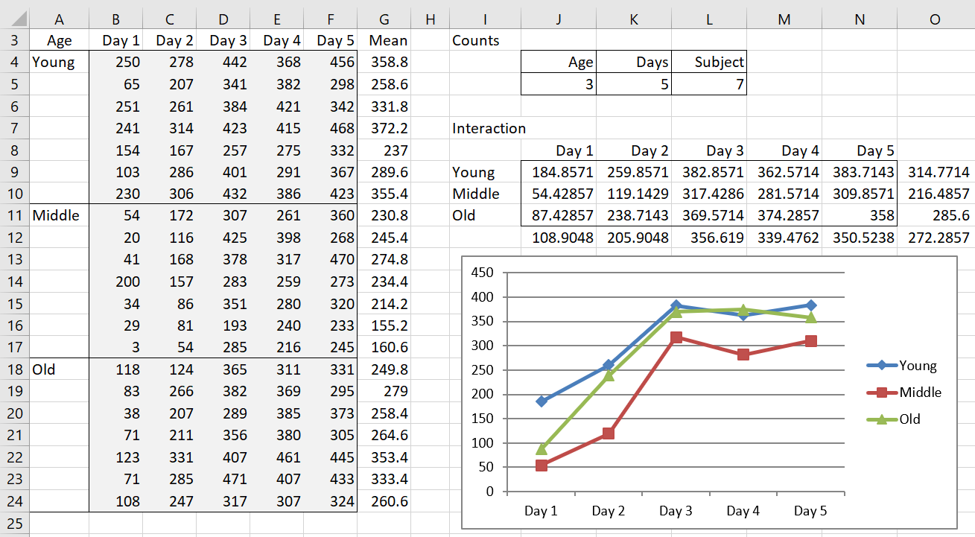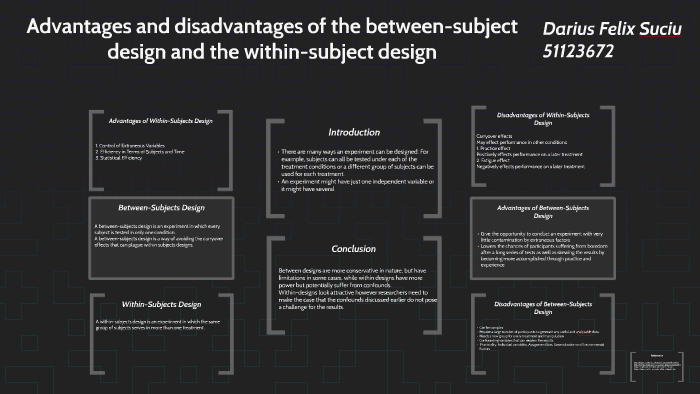Table Of Content

Consequently, for baseline potential differences, we analysed absolute values. We calculated a simple unweighted Spearman’s correlation coefficient for absolute within-study nPD values in CF versus control, using base R, prior to our planned analyses. For example, he could flip a coin to see if a participant will take the test in a 50 degree room or in an 85 degree room. By doing this, he is much less likely to end up with all the smart people in one room. Below are some common limitations experimenters face when choosing to use a between-subjects design. The main disadvantage of using a within subjects design is that an explicit action, which is that participants participate in one condition, can influence performance or behavior in all other conditions.
Within-Subjects Design Minimize the Noise in Your Data
If they know their group assignment, they may unintentionally or intentionally alter their responses to meet the researchers’ expectations, and this would lead to biased results. Every experimental group is given an independent variable treatment that the researcher believes will have some effect on the outcomes, while control groups are given no treatment, a standard unrelated treatment, or a fake treatment. In a between-subjects design, there is usually at least one control group and one experimental group, or multiple groups that differ on a variable (e.g., gender, ethnicity, test score, etc.). Even without such an obvious bias as your personal preferences, it’s easy to get randomization wrong.
Author & Researcher services
A 2 × 2 factorial design has four conditions, a 3 × 2 factorial design has six conditions, a 4 × 5 factorial design would have 20 conditions, and so on. Also notice that each number in the notation represents one factor, one independent variable. So by looking at how many numbers are in the notation, you can determine how many independent variables there are in the experiment.
Non-Manipulated Independent Variables
One group of participants were asked to rate the number 9 and another group was asked to rate the number 221 (Birnbaum, 1999)[4]. Participants in this between-subjects design gave the number 9 a mean rating of 5.13 and the number 221 a mean rating of 3.10. A within-subject design involves having all participants exposed to the exact same treatments. It can be a helpful way for researchers to learn more about how changes happen over time.
Increasing Precision without Altering Treatment Effects: Repeated Measures Designs in Survey Experiments - - Political Science Now
Increasing Precision without Altering Treatment Effects: Repeated Measures Designs in Survey Experiments -.
Posted: Fri, 17 Sep 2021 07:00:00 GMT [source]
Finally, performance on subsequent tests can also be affected by practice effects. Taking part in different levels of the treatment or taking the measurement tests several times might help the participants become more skilled. Participants may become exhausted, bored, or less motivated after taking part in multiple treatments or tests. Consider the earlier example of the experiment looking at exercise and memory.
This would mean that each participant would be tested in one and only one condition. There are no control groups in within-subjects designs because participants are tested before and after independent variable treatments. The pretest is similar to a control condition where no independent variable treatment is given yet, while the posttest takes place after all treatments are administered. In general, reproducibility of scientific experiments depends on knowledge of the experimental design details. For this SR, reporting of experimental details was worse than anything we came across before (the authors have worked on over 20 other SRs).
The company would like to test which of its two new sites will be more effective in attracting more customers. Each group interacts with only one of the site options, and the researchers observe which of the options the subjects liked the most and use this data for further development. This article describes between subjects design in the context of multi-user usability testing. The basic idea behind this type of study is that participants can be part of the treatment group or the control group, but cannot be part of both. If more than one treatment is tested, a completely new group is required for each.
For example, an average-looking defendant might be judged more harshly when participants have just judged an attractive defendant than when they have just judged an unattractive defendant. Within-subjects experiments also make it easier for participants to guess the hypothesis. So far, we have discussed an approach to within-subjects designs in which participants are tested in one condition at a time. There is another approach, however, that is often used when participants make multiple responses in each condition. Imagine, for example, that participants judge the guilt of 10 attractive defendants and 10 unattractive defendants. Instead of having people make judgments about all 10 defendants of one type followed by all 10 defendants of the other type, the researcher could present all 20 defendants in a sequence that mixed the two types.

Experimental design

Note that registered protocols were more common in the treatment vs. control comparisons. Of the human papers, 16 mentioned something about ongoing background treatments (e.g. “no regular medications” or “pancreatic supplements and antibiotic treatment”). Participants are told that they will receive the treatment but must wait until the participants in the treatment condition have already received it. This group does not receive the treatment or intervention that the other conditions do.
The primary disadvantage of within-subjects designs is that they can result in order effects. An order effect occurs when participants’ responses in the various conditions are affected by the order of conditions to which they were exposed. A carryover effect is an effect of being tested in one condition on participants’ behavior in later conditions. One type of carryover effect is a practice effect, where participants perform a task better in later conditions because they have had a chance to practice it. Another type is a fatigue effect, where participants perform a task worse in later conditions because they become tired or bored. Being tested in one condition can also change how participants perceive stimuli or interpret their task in later conditions.
During testing, the designer compares the effectiveness of the dependent variable between groups to see whether the independent variable is influential in the control groups. Between-subjects designs can be beneficial when exposure to one condition could influence responses to other conditions. This type of design is also useful when the testing procedure is long or strenuous, as participants only need to attend one session. For instance, in UX research, the independent variable could be different designs of a website, while the dependent variable might be the time users take to complete a specific task. You could divide your test subjects into groups and present each with a different design option. The different design options will be a manipulation of your independent variable.
With between-subject design, this transfer of knowledge is not an issue — participants are never exposed to several levels of the same independent variable. Each type of experimental design has its own advantages and disadvantages, and it is usually up to the researchers to determine which method will be more beneficial for their study. However, in between-subjects study designs, the participants are divided into different treatment groups, so one participant’s exposure to treatment will not affect the outcome of a subsequent condition. This method is called between-subjects because the differences in conditions occur between the groups of subjects.
A between-subjects design is also called an independent measures or independent-groups design because researchers compare unrelated measurements taken from separate groups. Individual participants bring in to the test their own history, background knowledge, and context. One may be tired after a long night of partying, another one may be bored, yet another one may have received a great news just before the study and be happy. If the same participant interacts with all levels of a variable, she will affect them in the same way. The happy person will be happy on both sites, the tired one will be tired on both. But if the study is between-subjects, the happy participant will only interact with one site and may affect the final results.
Between-subjects and within-subjects designs can be used in place of each other or in conjunction with each other. For example, exposure to a reaction time test could make participants’ reaction times faster in a subsequent treatment if the same subjects participated in both conditions. Information about the measuring electrode was reported in 32 (out of 55) animal and 51 (out of 73) human papers. Commonly used measuring electrodes were various Foley catheters, (pulled) PE-10 and PE-20 tubing, umbilical catheters and double-lumen silicone rubber tubes. Information about the bio-electrical connection was reported in 19 (out of 55) animal and 45 (out of 73) human papers and comprised continuous flow of the baseline buffer, agar bridges or electrode cream.
Or a researcher with a sample of 60 people with severe agoraphobia (fear of open spaces) might assign 20 of them to receive each of three different treatments for that disorder. It is essential in a between-subjects experiment that the researcher assign participants to conditions so that the different groups are, on average, highly similar to each other. This matching is a matter of controlling these extraneous participant variables across conditions so that they do not become confounding variables. Between subjects design, also known as an independent groups design, is a research method commonly used in experimental and quasi-experimental research.

No comments:
Post a Comment